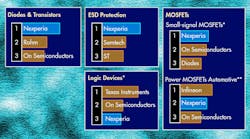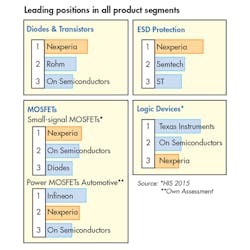This file type includes high resolution graphics and schematics when applicable.
Nexperia has been officially launched as an independent supplier of discrete, logic, and MOSFET devices.
While NXP will focus on its high-performance mixed-signal business, Nexperia will focus on automotive applications accelerating the introduction of new automotive products thanks to new investments in R&D and manufacturing.
These actions by Nexperia will put pressure on automotive semiconductor competitors such as Infineon and Renesas in a market whose revenue will grow at annual rate of 7.5% from 2015 to 2022, according to a report from IHS Markit. They may also shift the market in terms of international presence, as Nexperia is now owned by Beijing Jianguang Asset Management and private equity fund Wise Road Capital. They are just two of the many Chinese companies with new interest in the semiconductor industry. Those interests have been increasing since China’s government has started to actively improve the domestic market by creating a plan called “Made in China 2025” to reduce dependency on foreign technology to replace semiconductor imports.
To share the details of the deal, the standard product division of NXP, with its approximately 11,000 employees, was sold to the new owners for $2.75 billion. Nexperia will produce around 85 billion devices a year. In 2016, revenues exceeded $1.1 billion and the company had a market share of 30% in Europe, 15% in Asia, and 10% in United States. Nexperia plans to addresses three key trends: power efficiency; protection and filtering; and miniaturization through their different active type of devices, e.g., diodes and transistors, ESD protection, MOSFETs, and logic devices.
The automotive sector is very strong for Nexperia and most of its products are AECQ101-qualified. According to IHS 2015 and Nexperia itself, the company is in leading positions for small-signal MOSFETS and for Power MOSFET-Automotive (see figure).
I had a chance to speak with Frans Scheper, CEO of Nexperia, who says, “The automotive market is very important to Nexperia because there is a significant amount of power electronic components in electric vehicles and hybrid electric vehicles.” When questioned about potential uses of gallium-nitride technology, Scheper says, “In the upcoming months we will be launching new products based on gallium-nitride technology.”
Nexperia has two front-end manufacturing facilities, in Manchester, UK, and Hamburg, Germany, and three back-end packaging plants in Guangdong, China; Seremban, Malaysia; and Cabuyao, Philippines. Just recently, Nexperia had upgraded its UK chip fab from 6-in. to 8-in. wafers as part of an expansion of its manufacturing capacity. Scheper notes, “Because Nexperia will continue to source its front-end and back-end production from its current manufacturing sites, there will be no disruption in our supply chain or other processes, so customers and partners can be fully assured that they will continue to receive excellent products and exceptional service.”
In terms of quality of the products, Nexperia will continue to implement the same quality standards that they used to implement in the past when it was the standard products division of NXP. These include ISO9001, ISO/TS 16949 Automotive, ISO14001 Environmental, OHSAS18001 Health and Safety, etc. With new ISO standards now being introduced, Nexperia plans to move to these new standards during 2017.
I will keep watching how NXP Semiconductors evolves in the mixed-signal business and how Nexperia positions itself in the automotive market.
This file type includes high resolution graphics and schematics when applicable.




